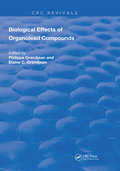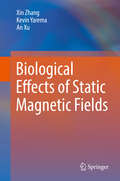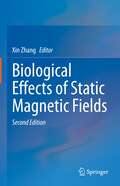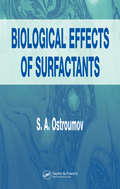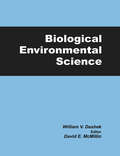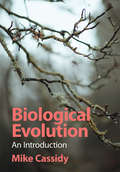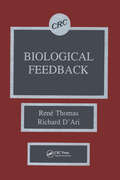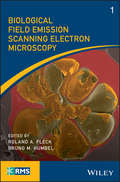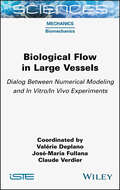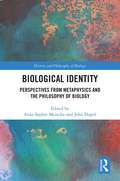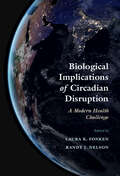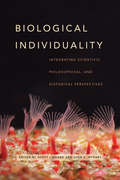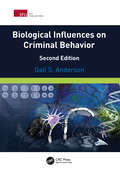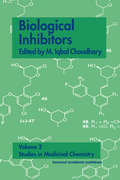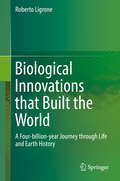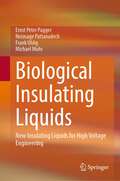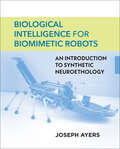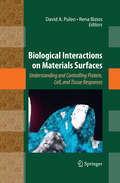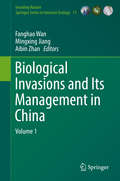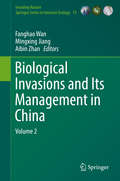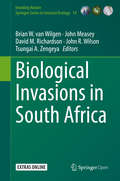- Table View
- List View
Biological Effects of Organolead Compounds (Routledge Revivals)
by M. A. Philippe Grandjean M. D. Ph. D. And Elaine C. Grand GrandjeanFirst published in 1984: This book is a compilation of research on Organolead Compounds.
Biological Effects of Static Magnetic Fields
by Xin Zhang Kevin Yarema An XuThe book summarize the emerging topic about the effects of SMF on biological samples ranging from single molecules, subcellular compartments, and cells to whole organisms, as well as the potential application of SMF in clinical treatment of cancer and other diseases. With the development and growing popularity of modern appliances, including MRI in the hospitals, the potential impact of magnetic fields on human health is invoking increasing concerns. At the same time, static magnetic field (SMF) has been used in the clinical treatment of tumors and other diseases for decades. However, there are still some reservations and uncertainties about these treatments, which are largely due to the differential biological effects reported in the literature. These experimental inconsistencies are mainly caused by variations such as different magnetic field types, intensities, treatment time as well as biological samples examined. This volume will help clarify some dilemmas in this field and encourage further investigation in order to achieve a better understanding of the biological effects of SMF, aiming for a rational application of SMF in clinical therapy in the near future. The book is useful for scientists and students in static magnetic field and clinical doctors et cl.
Biological Effects of Static Magnetic Fields
by Xin ZhangThe book summarizes the emerging topic about the effects of SMF on biological samples ranging from single molecules, subcellular compartments, and cells to whole organisms. It also discusses the potential application of SMF in clinical treatment of cancer, pain, diabetes and other diseases.With the development and growing popularity of modern appliances like MRI in hospitals, the potential impact of magnetic fields on human health is invoking increasing concerns. At the same time, SMF has been explored in the treatment of tumor and other diseases for decades. Nevertheless, there are still some reservations and uncertainties about these treatments, which are largely due to the differential biological effects reported in the literature. These experimental inconsistencies are mainly caused by variations such as different magnetic field types, intensities, treatment time, as well as biological samples examined. The second edition added eight new chapters about new progress in this field including impacts of SMFs, magnetism of biomolecules, and potential of SMFs in the management of bone, pain, diabetes, and immune systems. This volume will help clarify some dilemmas in this field and encourage further investigations in order to achieve a better understanding of the biological effects of SMF, aiming for a rational application of SMF in clinical therapy in the near future. The book is useful for scientists, doctors, and students who are interested in magnetic fields and life sciences
Biological Effects of Surfactants
by S.A. OstroumovOffering a new perspective on the hazards of pollution, Biological Effects of Surfactants examines the effects of anionic, non-ionic, cationic surfactants, and detergents on a wide range of organisms, populations, communities, and ecosystems. The author establishes new quantitative characteristics of the effects and presents study results on newly discovered phenomena. While proposing and substantiating new priorities and approaches for testing, assessing, and characterizing the biological activities and hazards of substances, the book illustrates how the data obtained can be used to develop effective environmental remediation and protection measures to improve water quality.
Biological Environmental Science
by William V DashekBiological Environmental Science is an introductory textbook for undergraduate students who desire a one semester course or, alternatively, a springboard course for advanced environmental offerings. This book features timely issues such as global warming, air, ground and water pollutions, population growth, species extinction and environmental policy. Unique features of this book include the use of research data and literature, copious illustrations and appendices for the scientific method.
Biological Evidence
by Ann Bucholtz Jon Lewis"The text is an introduction to the types of biological evidence commonly found at crime scenes and how to collect it for non-science majors and for professionals working in the criminal justice system. Specific biological evidence discussed includes blood, semen, saliva, urine, feces, hair, and fingernails. Additional topics include autopsy, the basic departments of the crime laboratory, toxicology, forensic entomology, and uncollectible biological evidence. Packaging, preservation, and care of biological evidence is discussed and chain of custody is explained. Additional topics include DNA, case studies, courtroom testimony, and exhibits for the courtroom.
Biological Evolution: An Introduction
by Mike CassidyBiological evolution, the theory of natural selection and of common descent, is a triumph both of human reasoning and scientific undertaking. The biological discipline of evolution contains both a chronicle of human endeavour and the story of life on Earth. This book is concerned with living forms and how they developed from 'simple and unpromising beginnings'. It considers evolution as both process and product. The author, an experienced teacher and educator, employs a historical narrative, used to convey the idea of 'change with modification' and to emphasise the relevance of evolution to contemporary bioscience. Biological evolution has now become part of the scientific orthodoxy and this accessible text will assist undergraduate students in the biological sciences within any ongoing debate.
Biological Extinction: New Perspectives
by Partha Dasgupta Peter H. Raven Anna L. McIvorThe rapidly increasing human pressure on the biosphere is pushing biodiversity into the sixth mass extinction event in the history of life on Earth. The organisms being exterminated are integral working parts of our planet's life support system, and their loss is permanent. Like climate change, this irreversible loss has potentially devastating consequences for humanity. As we come to recognise the many ways in which we depend on nature, this can pave the way for a new ethic that acknowledges the importance of co-existence between humans and other species. Biological Extinction features chapters contributed by leading thinkers in diverse fields of knowledge and practice, including biology, economics, geology, archaeology, demography, architecture and intermediate technology. Drawing on examples from various socio-ecological systems, the book offers new perspectives on the urgent issue of biological extinction, proposing novel solutions to the problems that we face.
Biological Feedback
by Rene Thomas Richard D'AriClearly explaining the logical analysis of biological control phenomena, Biological Feedback answers questions concerning everything from regulation to logic. This rare monograph presents a formal methodology for analyzing the dynamic behavior of complex systems. The easy-to-read text describes a simple logical formalization called "kinetic logic". The reader discovers how this method is used to predict all possible patterns of behavior of which a system is capable. It includes specific conditions required for each pattern. It also explains how to modify an incorrect model in order to account for the observed behavior. The authors give special attention to the two basic types of simple feedback loops: positive and negative. This volume is filled with easy-to-use tables, providing quick reference throughout the book. The subject matter is of great interest to everyone working in molecular genetics and developmental biology. Researchers, immunologists, physical chemists, physicists, electrical engineers, economists, and mathematicians will find this unique text to be an informative, indispensable resource.
Biological Field Emission Scanning Electron Microscopy (RMS - Royal Microscopical Society)
by Roland A. Fleck Bruno M. HumbelThe go‐to resource for microscopists on biological applications of field emission gun scanning electron microscopy (FEGSEM) The evolution of scanning electron microscopy technologies and capability over the past few years has revolutionized the biological imaging capabilities of the microscope—giving it the capability to examine surface structures of cellular membranes to reveal the organization of individual proteins across a membrane bilayer and the arrangement of cell cytoskeleton at a nm scale. Most notable are their improvements for field emission scanning electron microscopy (FEGSEM), which when combined with cryo-preparation techniques, has provided insight into a wide range of biological questions including the functionality of bacteria and viruses. This full-colour, must-have book for microscopists traces the development of the biological field emission scanning electron microscopy (FEGSEM) and highlights its current value in biological research as well as its future worth. Biological Field Emission Scanning Electron Microscopy highlights the present capability of the technique and informs the wider biological science community of its application in basic biological research. Starting with the theory and history of FEGSEM, the book offers chapters covering: operation (strengths and weakness, sample selection, handling, limitations, and preparation); Commercial developments and principals from the major FEGSEM manufacturers (Thermo Scientific, JEOL, HITACHI, ZEISS, Tescan); technical developments essential to bioFEGSEM; cryobio FEGSEM; cryo-FIB; FEGSEM digital-tomography; array tomography; public health research; mammalian cells and tissues; digital challenges (image collection, storage, and automated data analysis); and more. Examines the creation of the biological field emission gun scanning electron microscopy (FEGSEM) and discusses its benefits to the biological research community and future value Provides insight into the design and development philosophy behind current instrument manufacturers Covers sample handling, applications, and key supporting techniques Focuses on the biological applications of field emission gun scanning electron microscopy (FEGSEM), covering both plant and animal research Presented in full colour An important part of the Wiley-Royal Microscopical Series, Biological Field Emission Scanning Electron Microscopy is an ideal general resource for experienced academic and industrial users of electron microscopy—specifically, those with a need to understand the application, limitations, and strengths of FEGSEM.
Biological Flow in Large Vessels: Dialog Between Numerical Modeling and In Vitro/In Vivo Experiments
by Valerie Deplano Jose-Maria Fullana Claude VerdierThis book examines recent methods used for blood flow modeling and associated in vivo experiments, conducted using experimental data from medical imaging. Different strategies are proposed, from smallscale models to complex 3D modeling using modern computational codes. The geometries are wide-ranging and deal with the narrowing and widening of sections (stenoses, aneurysms), bifurcations, geometries associated with prosthetic elements, and even cases of vessels with smaller dimensions than those of the blood cells circulating in them.Biological Flow in Large Vessels provides answers to the question of how medical and biomechanical knowledge can be combined to address clinical problems. It offers guidance for further development of numerical models, as well as experimental protocols applied to clinical research, with tools that can be used in real-time and at the patient’s bedside, for decision-making support, predicting the progression of pathologies, and planning personalized interventions.
Biological Functions for Information and Communication Technologies: Theory and Inspiration (Studies in Computational Intelligence #320)
by Hidefumi SawaiBy incorporating biologically-inspired functions into ICT, various types of new-generation information and communication systems can be created. Just some example of areas already benefiting from such design inspiration are network architectures, information processing, molecular communication, and complex network modeling for solving real world-problems. This book provides the theoretical basis for understanding these developments and explains their practical applications. Highlighted inserts appears throughout to help readers to understand the very latest topics in these emerging research fields. The book ends with a more philosophical discussion on how new ICT solutions can be found by looking at analogous systems in biology. This new way of thinking may help researchers and practitioners to apply innovative ideas in developing next-generation technologies.
Biological Identity: Perspectives from Metaphysics and the Philosophy of Biology (History and Philosophy of Biology)
by Anne Sophie MeinckeAnalytic metaphysics has recently discovered biology as a means of grounding metaphysical theories. This has resulted in long-standing metaphysical puzzles, such as the problems of personal identity and material constitution, being increasingly addressed by appeal to a biological understanding of identity. This development within metaphysics is in significant tension with the growing tendency amongst philosophers of biology to regard biological identity as a deep puzzle in its own right, especially following recent advances in our understanding of symbiosis, the evolution of multi-cellular organisms and the inherently dynamical character of living systems. Moreover, and building on these biological insights, the broadly substance ontological framework of metaphysical theories of biological identity appears problematic to a growing number of philosophers of biology who invoke process ontology instead. This volume addresses this tension, exploring to what extent it can be dissolved. For this purpose, the volume presents the first selection of essays exclusively focused on biological identity and written by experts in metaphysics, the philosophy of biology and biology. The resulting cross-disciplinary dialogue paves the way for a convincing account of biological identity that is both metaphysically constructive and scientifically informed, and will be of interest to metaphysicians, philosophers of biology and theoretical biologists.
Biological Individuality: Integrating Scientific, Philosophical, and Historical Perspectives
by Lynn K. Nyhart Scott Lidgard and Lynn K. NyhartIndividuals are things that everybody knows—or thinks they do. Yet even scholars who practice or analyze the biological sciences often cannot agree on what an individual is and why. One reason for this disagreement is that the many important biological individuality concepts serve very different purposes—defining, classifying, or explaining living structure, function, interaction, persistence, or evolution. Indeed, as the contributors to Biological Individuality reveal, nature is too messy for simple definitions of this concept, organisms too quirky in the diverse ways they reproduce, function, and interact, and human ideas about individuality too fraught with philosophical and historical meaning. Bringing together biologists, historians, and philosophers, this book provides a multifaceted exploration of biological individuality that identifies leading and less familiar perceptions of individuality both past and present, what they are good for, and in what contexts. Biological practice and theory recognize individuals at myriad levels of organization, from genes to organisms to symbiotic systems. We depend on these notions of individuality to address theoretical questions about multilevel natural selection and Darwinian fitness; to illuminate empirical questions about development, function, and ecology; to ground philosophical questions about the nature of organisms and causation; and to probe historical and cultural circumstances that resonate with parallel questions about the nature of society. Charting an interdisciplinary research agenda that broadens the frameworks in which biological individuality is discussed, this book makes clear that in the realm of the individual, there is not and should not be a direct path from biological paradigms based on model organisms through to philosophical generalization and historical reification.
Biological Influences on Criminal Behavior
by Gail AndersonBiological Influences on Criminal Behavior, Second Edition is fully updated to include recent research, studies, and publications examining the integration of the biological view with mainstream social, psychological, and environmental views in influences in criminality and criminal behavior. The first edition of the book was written with the belief, grounded in research, that something vital can be discovered when we assess all the factors related to the causes of crime, including biology. Since the first edition published, it has become broadly accepted that biology is certainly a factor in criminal behavior, albeit a singular piece to the puzzle. Increased collaborations between scientists and criminologists has led to a much stronger understanding of the intricacies of biology’s role in behavior. As well, more criminologists have biological backgrounds. As the science involved became more complex, so too did this text. This second edition considers the more recent and integrated research that is being conducted today to show the interaction between the environment and a person’s biology that lead to our behavior. It has even been shown that the environment acts on, and actually changes the functions, of some genes. The book begins with basic scientific principles and advances to introduce the reader to the more in-depth discussions of various biological influencers. Biological Influences on Criminal Behavior, Second Edition is written primarily for social science and law students who wish to understand this exciting area. The book offers a greater understanding of this rapidly growing field so that its lessons can help to inform policy, treatments, rehabilitation and the law.
Biological Inhibitors
by M. Iqbal ChoudharyThis book, a part of the series Studies in Medicinal Chemistry, details the biological inhibitors that reflect drug discovery in treating human diseases, including cardiovascular, nervous, inflammatory, hormonal and metabolic processes. Compounds for fungal diseases and HIV/AIDS are also covered.
Biological Innovations that Built the World: A Four-billion-year Journey through Life and Earth History
by Roberto LigroneThe book is a detailed account of major biological events that contributed to create the present world and our species, with emphasis on cause-effect interrelationships and environmental impact. Its main goal is to guide the reader toward an understanding of the continuity of life across diversity, and of its large-scale interactions with the planet. Combining scientific soundness with a constant effort for clarity, the book begins with a cloud of dust in a corner of the Galaxy and, covering an immense lapse of time, terminates with an organism that ponders about the texture of the Universe. Comprehensive, updated references added to each chapter will help the reader wishing to expand any of the topics. A glossary explains less common technical terms.
Biological Insulating Liquids: New Insulating Liquids for High Voltage Engineering
by Frank Uhlig Ernst Peter Pagger Norasage Pattanadech Michael MuhrThis book describes the state-of-the-art use of biological insulating liquids in detail. In recent years, more and more transformers filled with esters have been put into operation. This is because people recognize the benefits of ester liquids in terms of their fire safety (high flash and fire points) and environmental characteristics, judging from their biodegradability, their low CO2 footprint (only valid for natural ester) and their beneficial interactions with solid insulation, etc. One of the main reasons is that the water adsorption and absorption characteristics of these liquids are excellent and very different compared to mineral oil. The today’s discussion about climate change and global warming is an additional driver for using natural ester. Another advantage is that transformers filled with biological insulating liquids can operate with an overload of up to 150%. This is advantageous in the case of volatile energy generation from wind and solar power and in the supply of electrical energy for electromobility. Liquid inside electrical equipment is the lifeblood that serves both as a dielectric and a cooling medium. Some properties of these liquids differ from mineral oil, which had to be considered in the transformer design. The dielectric liquid is always in direct contact with transformer materials; therefore, the interaction should be very well understood, especially when retrofilling an existing mineral oil filled device. There are several natural ester fluids derived from various seeds and fruits on the market, and their properties may differ more or less. In the book, the most important properties of the different biological insulating fluids and mineral oil are compared. Ester fluids have already found their way into various standards. The condition of the device can be verified very well from the contents of the insulating liquids. For analysis and testing, the same equipment and devices that are commonly used for mineral oil are used for ester liquid. The chemical and physical behaviors of ester fluids compared to mineral oil are different. This must always be considered when interpreting test results stemming from ester fluids. The book is a guideline for students, original equipment manufacturers, users, laboratories and authorities in the use of biological insulating liquids.
Biological Intelligence for Biomimetic Robots: An Introduction to Synthetic Neuroethology
by Joseph AyersAn introduction to how neuroethology can inform the development of robots controlled by synaptic networks instead of algorithms, from a pioneer in biorobotics.The trait most fundamental to the evolution of animals is the capability to adapt to novel circumstances in unpredictable environments. Recent advances in biomimetics have made it feasible to construct robots modeled on such unsupervised autonomous behavior, and animal models provide a library of existence proofs. Filling an important gap in the field, this introductory textbook illuminates how neurobiological principles can inform the development of robots that are controlled by synaptic networks, as opposed to algorithms. Joseph Ayers provides a comprehensive overview of the sensory and motor systems of a variety of model biological systems and shows how their behaviors may be implemented in artificial systems, such as biomimetic robots. Introduces the concept of biological intelligence as applied to robots, building a strategy for autonomy based on the neuroethology of simple animal modelsProvides a mechanistic physiological framework for the control of innate behaviorIllustrates how biomimetic vehicles can be operated in the field persistently and adaptivelyDeveloped by a pioneer in biorobotics with decades of teaching experienceProven in the classroom Suitable for professionals and researchers as well as undergraduate and graduate students in cognitive science and computer science
Biological Interactions on Materials Surfaces: Understanding and Controlling Protein, Cell, and Tissue Responses
by Rena Bizios David A. PuleoSuccess or failure of biomaterials, whether tissue engineered constructs, joint and dental implants, vascular grafts, or heart valves, depends on molecular-level events that determine subsequent responses of cells and tissues. This book presents the latest developments and state-of-the-art knowledge regarding protein, cell, and tissue interactions with both conventional and nanophase materials. Insight into these biomaterial surface interactions will play a critical role in further developments in fields such as tissue engineering, regenerative medicine, and biocompatibility of implanted materials and devices. With chapters written by leaders in their respective fields, this compendium will be the authoritative source of information for scientists, engineers, and medical researchers seeking not only to understand but also to control tissue-biomaterial interactions.
Biological Invasions and Animal Behaviour
by Weis Judith S. Daniel SolHow does behaviour affect biological invasions? Can it explain why some animals are such successful invaders? With contributions from experts in the field, and covering a broad range of animals, this book examines the role of behaviour in biological invasions from the point of view of both invaders and native species. The chapters cover theoretical aspects, particularly relevant behaviours and well-documented case studies, showing that behaviour is critical to the success, and ecological and socio-economic impact, of invasive species. Its insights suggest methods to prevent and mitigate those impacts, and offer unique opportunities to understand the adaptive role of behaviour. Offering a comprehensive overview of current understanding on the subject, the book is intended for biological invasion researchers and behavioural ecologists as well as ecologists and evolutionary biologists interested in how organisms deal with anthropogenic environmental changes such as climate change and habitat loss.
Biological Invasions and Its Management in China: Volume 1 (Invading Nature - Springer Series in Invasion Ecology #11)
by Fanghao Wan Mingxing Jiang Aibin ZhanThe book discusses invasive-species problems in agriculture, forests and aquatic ecosystems, highlighting the invasive mechanisms and management of the selected invasive species. Biological invasion has become a serious global ecological and economic problem that deserves particular attention from both government officials and scientists. This volume focuses on three key scientific areas: 1) population establishment and spreading mechanisms of the selected invasive species; 2) ecology adaptation, population growth, expansion and evolution of invasive species; and 3) impact of bio-invasion on the ecosystem structure and function at community and ecosystem levels. The presented research will result in techniques for better management of invasive species. Dr. Fanghao Wan is a professor at the Chinese Academy of Agricultural Sciences Institute of Plant Protection in Beijing, China. Dr. Mingxing Jiang is a professor at Zhejiang University's College of Agriculture and Biotechnology Institute of Insect Sciences in Hangzhou, China. Dr. Aibin Zhan is a researcher at the Center for Eco-Environmental Sciences (RCEES) at the Chinese Academy of Sciences (CAS), Beijing, China.
Biological Invasions and Its Management in China: Volume 2 (Invading Nature - Springer Series in Invasion Ecology #13)
by Fanghao Wan Mingxing Jiang Aibin ZhanThe book discusses invasive-species problems in agriculture, forests and aquatic ecosystems, highlighting the invasive mechanisms and management of the selected invasive species. Biological invasion has become a serious global ecological and economic problem that deserves particular attention from both government officials and scientists. This volume focuses on three key scientific areas: 1) population establishment and spreading mechanisms of the selected invasive species; 2) ecology adaptation, population growth, expansion and evolution of invasive species; and 3) impact of bio-invasion on the ecosystem structure and function at community and ecosystem levels. The presented research will result in techniques for better management of invasive species. Dr. Fanghao Wan is a professor at the Chinese Academy of Agricultural Sciences Institute of Plant Protection in Beijing, China. Dr. Mingxing Jiang is a professor at Zhejiang University's College of Agriculture and Biotechnology Institute of Insect Sciences in Hangzhou, China. Dr. Aibin Zhan is a researcher at the Center for Eco-Environmental Sciences (RCEES) at the Chinese Academy of Sciences (CAS), Beijing, China.
Biological Invasions in South Africa (Invading Nature - Springer Series in Invasion Ecology #14)
by David M. Richardson John R. Wilson Brian W. van Wilgen John Measey Tsungai A. ZengeyaThis open access volume presents a comprehensive account of all aspects of biological invasions in South Africa, where research has been conducted over more than three decades, and where bold initiatives have been implemented in attempts to control invasions and to reduce their ecological, economic and social effects. It covers a broad range of themes, including history, policy development and implementation, the status of invasions of animals and plants in terrestrial, marine and freshwater environments, the development of a robust ecological theory around biological invasions, the effectiveness of management interventions, and scenarios for the future. The South African situation stands out because of the remarkable diversity of the country, and the wide range of problems encountered in its varied ecosystems, which has resulted in a disproportionate investment into both research and management. The South African experience holds many lessons for other parts of the world, and this book should be of immense value to researchers, students, managers, and policy-makers who deal with biological invasions and ecosystem management and conservation in most other regions.
